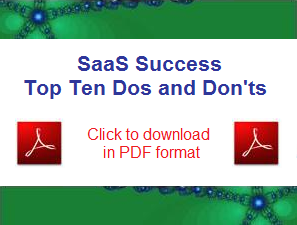
Save it or share it with a colleague.
Click the image above to download the SaaS Top Ten PDF.
For more SaaS business strategy tips,visit or subscribe to Chaotic Flow by Joel York
Or, click below to read the SaaS Top Ten Dos and Don'ts online...
SaaS Do #1 - Choose a Large Market
SaaS Do #2 - Create a Hub on the Web
SaaS Do #3 - Accelerate Organic Growth
SaaS Do #4 - Craft a Compelling Story
SaaS Do #5 - Build the Business into the Product
SaaS Do #6 - Reach across the Firewall
SaaS Do #7 - Monetize Creatively
SaaS Do #8 - Enable Mass Customization
SaaS Do #9 - Open Up to the Cloud
SaaS Do #10 - Leverage Your Community
SaaS Don't #1 - Chase Elephants
SaaS Don't #2 - Waste Money Marketing Offline
SaaS Don't #3 - Launch without Online Trial
SaaS Don't #4 - Cover up Shortcomings with People
SaaS Don't #5 - Invest in Channel Partners too Early
SaaS Don't #6 - Bleed Cash Indefinitely
SaaS Don't #7 - Ignore the Long Tail
SaaS Don't #8 - Think You Can Control It
Software-as-a-Service
Success
The Top Ten Dos and Don’ts of SaaS Business Success
In his book All Marketers are Liars, Seth Godin asserts that people don’t buy products, they buy stories. Stories they tell themselves to rationalize the decision to buy, and stories they tell themselves after to feel good about their actions. There are few things scarier to a marketer than relying on organic growth and word-of-mouth to drive demand and inbound leads. Telling a great story is one of the few elements of online demand generation over which you can truly exercise a great deal of control. This opportunity should not be squandered. Great stories should be the foundation of your online marketing plan, because on the Web you have a) even less time to get people’s attention, b) tons of low cost, cool multi-media options to deliver dyour story and c) built-in automation to spread your content virally provided that it is genuinely interesting and entertaining. And, if you want your message to stick and fuel offline word-of-mouth once your prospect has closed her browser, it had better be a memorable one.
You might think that in this era of search ad headlines with 25 character limits that telling a story with many variations and nuances is both hard and irrelevant, but this is not true. Great stories have legs and can be recast, repurposed, reinterpreted and remembered—all while returning to a common theme that forms the essence of your brand. It is worth emphasizing here that your stories need to be great, not just good, and definitely not just good enough. Two strong examples from completely opposite ends of the Internet spectrum are Twitter and Salesforce.com. Both stories begin with a really simple idea “No software” and “What are you doing?” respectively. But, the variations on these simple themes are endless. For Twitter, the story unwinds like a fractal into an incredibly detailed tapestry spun by its own community of users all tweeting away about what they are doing. In the case of Salesforce.com, the story was crafted and delivered with the consistency and skill of a presidential campaign directed squarely at the incumbent, enterprise software.
If you want to generate organic demand, site traffic and leads. If you want to create viral video that will get millions of hits on YouTube. Start by crafting a great story and the rest will follow with a lot less work and machination.